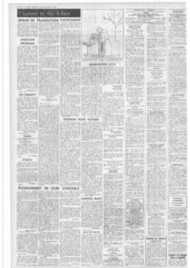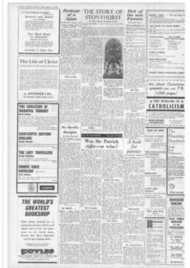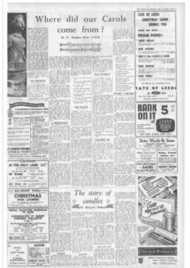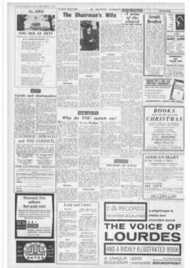Page 8, 7th December 1962
Page 8

Report an error
Noticed an error on this page?If you've noticed an error in this article please click here to report it.
Tags
Share
Related articles
The Art Of Sending Christmas Cards
Christmas As Seen By Gpo
Who Cooked Up Mother's Day?
Closer Market Research Needed
Commercial Christmas
BEHIND THOSE SEASONAL GREETINGS
By Geoffrey Humphrys
EVER since their inception
Christmas cards have been closely connected with art publishing. As might be expected, the association has resulted in some of the religious pictures of the world's most famous painters being reproduced for the sending of seasonal greetings.
The popularity of Christmas carols is undoubtedly due to the simplicity of the words describing the first Bethlehem Christmas, and a similar simplicity is apparent in the holy pictures of the Nativity scene reproduced on Christmas cards.
In these days of rapidlyspreading commercialisation of the Christmas season, it is good to know that Catholics are largely responsible for preserving the holiness of the season by buying what are often referred to disparagingly as "religious cards".
600 MILLION
Not all of us can go to the lengths of a wealthy Spaniard who commissioned a Royal Academician to copy a Botticelli picture of the Madonna. When completed this was set in gems and sent to a friend as a Christmas card.
This gesture was one of heart. felt devotion, but a recent adaptation of the same idea in Dallas, Texas, borders on the ridiculous. Here, in a local store, a speciality "romance" line was mink-lined Christmas cards studded with diamonds.
In Britain last year 600 million Christmas cards were sold —the majority of them, regrettably, far removed from the scene which is the true celebration of Christmas. Many of them, however, featured bells, and Christmas is, after all, a time for bell-ringing.
It was St. Dunstan of Canterbury who started the custom of ringing the bells at frequent intervals throughout the Christmas Octave, insisting that the Feast of the Nativity was an occasion of celebration and merriment. "Ring the bells," he told his monks, "so that men may raise their hearts in thankfulness". And he was very severe on any monk who forgot his duty at the appointed hour.
Christmas card scenes por. traying the unity of family life are in keeping with the tradition and example of the Holy Family. The Crib, of course, is still a favourite Christmas card scene, and it is gratifying to see that Crib cut-outs on the "do-ityourself" principle are becoming increasingly popular. Quite definitely, every Catholic home should have some representation of the Crib among its Christmas decorations.
THE FIRST
William May Egley, a London engraver's apprentice, is generally considered to he the first to make Christmas cards in hulk. He made one hundred in 1842.
In the following year, Sir Henry Cole, Director of the British Museum, had some cards printed in lithography and coloured by hand. The card was designed by J. C. Horsely, R.A The central panel pictured a Victorian family Christmas party, while the two side panels
illustrated the traditional charities of "feeding the hungry" and "clothing the destitute".
The central panel caused a great deal of protest, for eight of the eleven members of the party were depicted drinking wine. Many people thought this would encourage drunkenness. The artist was offended by the criticism, but in ensuing years he had ample opportunity of censuring totally inappropriate Christmas card designs.
A PIONEER
One of the pioneers of the Christmas card was the late Sir Adolph Tuck. He had the true spirit of Christmas firmly in mind when he made his first batch of them at the back of his father's art publishing shop in 1871. He offered the famous Lord Tennyson £1,000 to write a special 32-line poem for these cards. The offer was refused.
The custom of sending cards did not catch on immediately, but it was practised sufficiently for "The Times" of that year to complain of "the delay of legitimate correspondence by children's cards."
In 1880, Adolph Tuck held a nation-wide competition for Christmas card designs. To ensure artistic integrity he persuaded Sir John Millais, President of the Royal Academy, to judge the entries. There were 3,000 designs submitted and they were exhibited in the Dudley Gallery, Large crowds came to see them, and the annual sale of Christmas cards went up. The following year, the Post Office issued the first of its now familiar appeals to "Post Early for Christmas".
Many of the religious paintings of the old masters were reproduced on Christmas cards, with the Holy Mother and Child receiving special attention. Some of the present day reproductions of these are of exceptionally high standard.
The thought behind sending the Christmas card is more important than the picture it portrays, and even If the words are not printed or written, most Catholics think or them as a means of saying "God Bless You" as well as "A Happy Christmas".
It is fitting that many charitable organisations have taken advantage of the boom in Christmas cards as a means of raising much-needed funds. This, of course, can he overdone, but there are many deserving Catholic causes which can be supported merely by buying their Christmas cards and seals,
GOOD WORK
Excellent Christian work has been done for orphan and physically handicapped children by means of these Christmas tokens. In December, 1956, the Lord Mayor of London issued Christmas cards to be sold by all civic authorities. They cost one shilling each, and by special concessions from the Treasury, were free from purchase tax to aid the I.ord Mayor's Hungarian Relief Fund. Many Catholics benefited from this truly Christ. ian endeavour, There is no better time to count one's own blessings than at Christmas. It is also the time when we should make a special effort to help those who are not so fortunate, to remind them that the spirit of Our Blessed Lord is not forgotten. A first step can he taken by merely buying and sending a few wellchosen Christmas cards.
blog comments powered by Disqus

















